Talent Planning and Workforce Management: ARGOS Case Study Report
VerifiedAdded on 2021/01/02
|18
|4934
|393
Report
AI Summary
This report delves into the critical aspects of talent planning and its impact on organizational success, using ARGOS as a case study. It analyzes current market trends such as globalization, environmental sustainability, demographic and technological changes, and urbanization, highlighting their influence on workforce planning. The report also outlines the legal requirements essential for effective workforce planning, including the Equality Act of 2010, the Anti-Discrimination Act of 1994, fair HRM policies, and maternity/paternity benefits. Furthermore, it examines anticipated skills requirements based on labor market trends and legal mandates, providing examples of skills needed in various contexts. The report details job and person specifications for successful recruitment and selection, and applies different recruitment and selection methods. Finally, it evaluates the stages of the HR life-cycle within specific HR contexts and integrates these stages within the organizational HR strategy, offering a comprehensive overview of talent management practices.
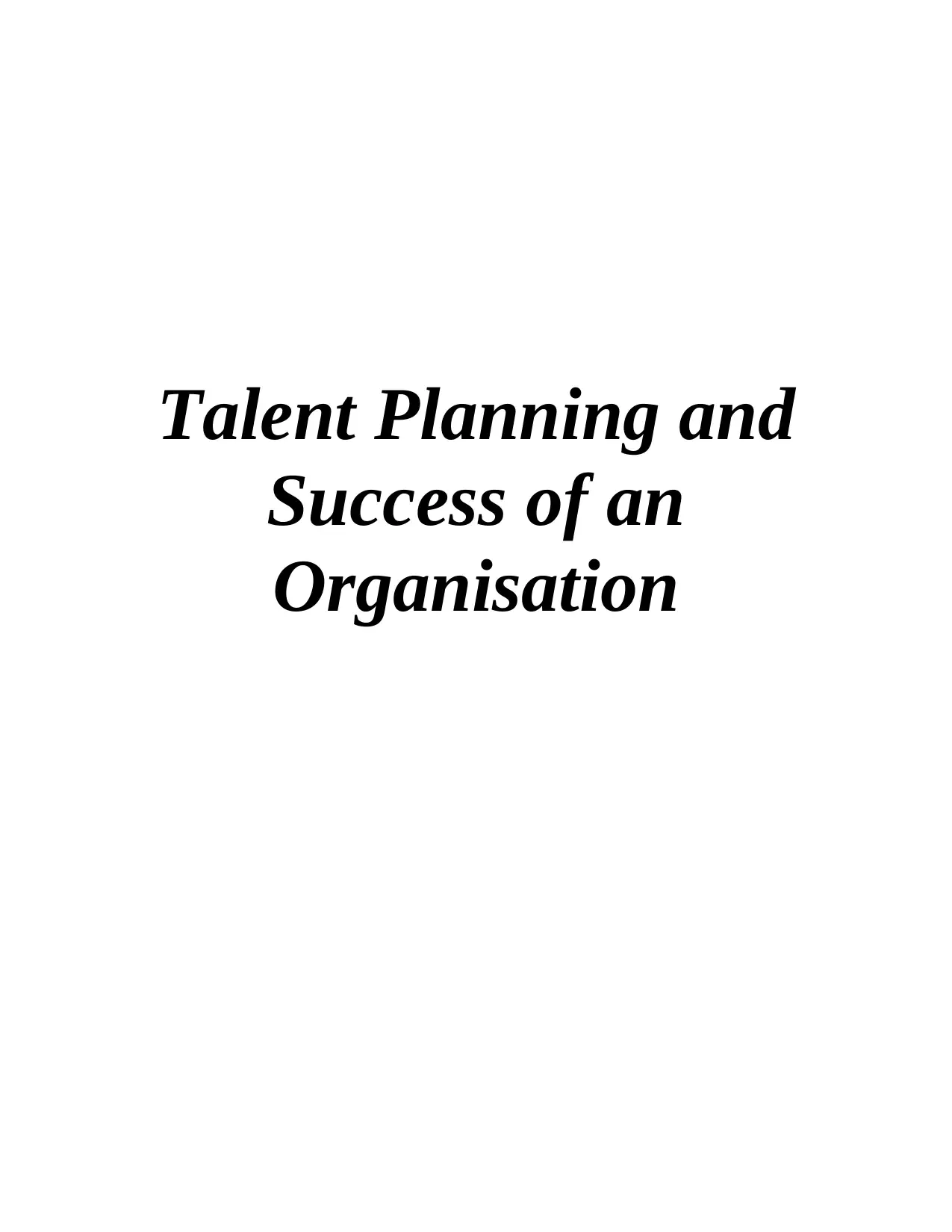
Talent Planning and
Success of an
Organisation
Success of an
Organisation
Paraphrase This Document
Need a fresh take? Get an instant paraphrase of this document with our AI Paraphraser
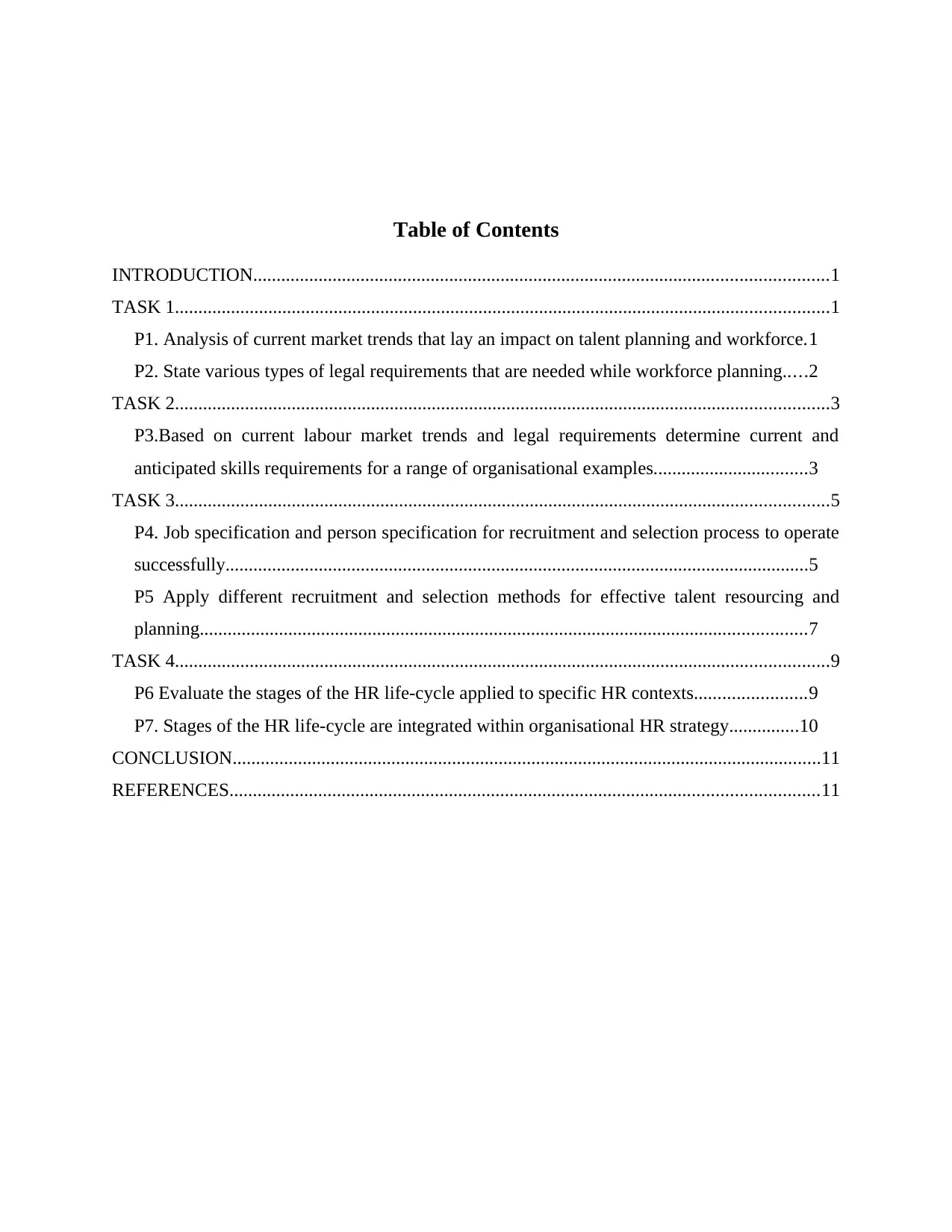
Table of Contents
INTRODUCTION...........................................................................................................................1
TASK 1............................................................................................................................................1
P1. Analysis of current market trends that lay an impact on talent planning and workforce.1
P2. State various types of legal requirements that are needed while workforce planning.....2
TASK 2............................................................................................................................................3
P3.Based on current labour market trends and legal requirements determine current and
anticipated skills requirements for a range of organisational examples.................................3
TASK 3............................................................................................................................................5
P4. Job specification and person specification for recruitment and selection process to operate
successfully.............................................................................................................................5
P5 Apply different recruitment and selection methods for effective talent resourcing and
planning..................................................................................................................................7
TASK 4............................................................................................................................................9
P6 Evaluate the stages of the HR life-cycle applied to specific HR contexts........................9
P7. Stages of the HR life-cycle are integrated within organisational HR strategy...............10
CONCLUSION..............................................................................................................................11
REFERENCES..............................................................................................................................11
INTRODUCTION...........................................................................................................................1
TASK 1............................................................................................................................................1
P1. Analysis of current market trends that lay an impact on talent planning and workforce.1
P2. State various types of legal requirements that are needed while workforce planning.....2
TASK 2............................................................................................................................................3
P3.Based on current labour market trends and legal requirements determine current and
anticipated skills requirements for a range of organisational examples.................................3
TASK 3............................................................................................................................................5
P4. Job specification and person specification for recruitment and selection process to operate
successfully.............................................................................................................................5
P5 Apply different recruitment and selection methods for effective talent resourcing and
planning..................................................................................................................................7
TASK 4............................................................................................................................................9
P6 Evaluate the stages of the HR life-cycle applied to specific HR contexts........................9
P7. Stages of the HR life-cycle are integrated within organisational HR strategy...............10
CONCLUSION..............................................................................................................................11
REFERENCES..............................................................................................................................11
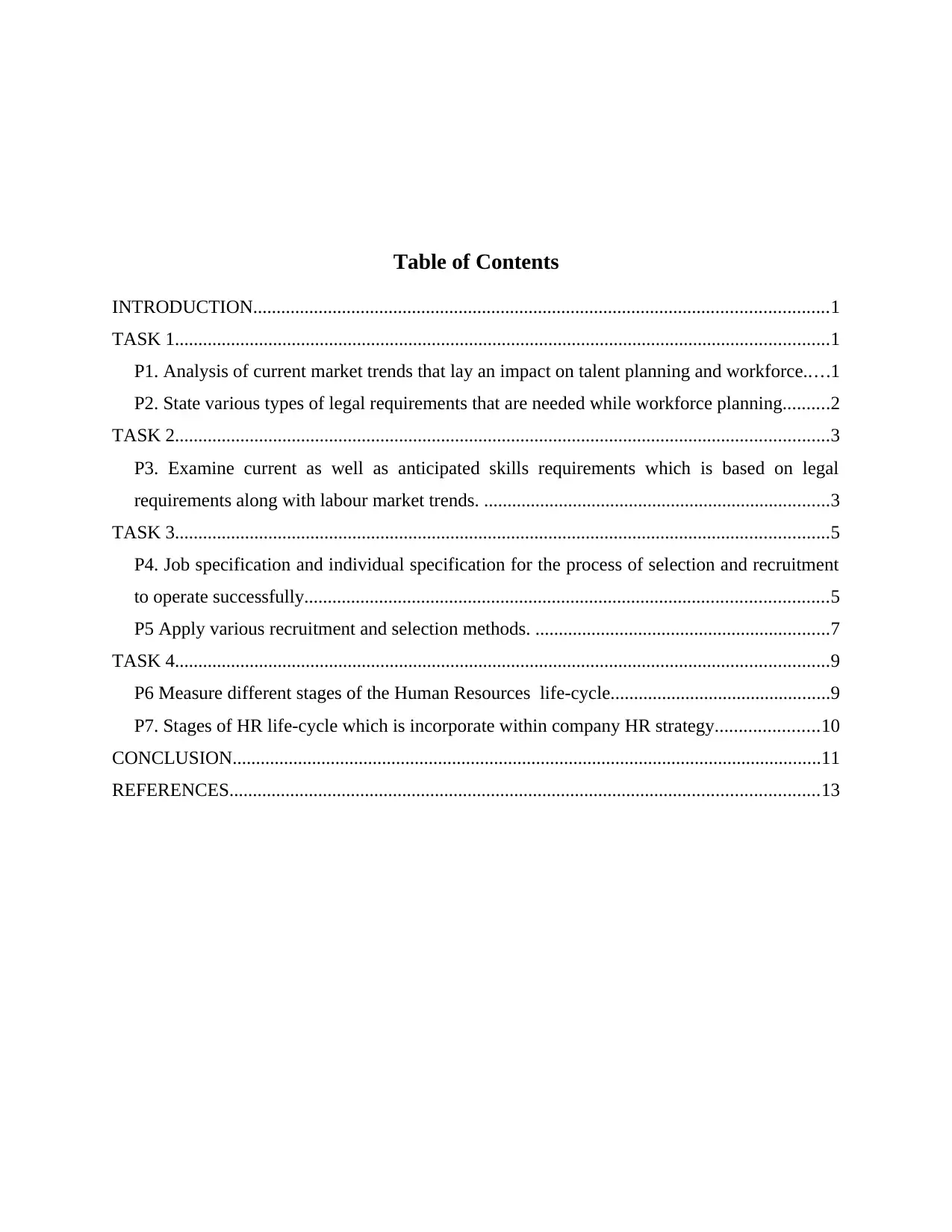
Table of Contents
INTRODUCTION...........................................................................................................................1
TASK 1............................................................................................................................................1
P1. Analysis of current market trends that lay an impact on talent planning and workforce.....1
P2. State various types of legal requirements that are needed while workforce planning..........2
TASK 2............................................................................................................................................3
P3. Examine current as well as anticipated skills requirements which is based on legal
requirements along with labour market trends. ..........................................................................3
TASK 3............................................................................................................................................5
P4. Job specification and individual specification for the process of selection and recruitment
to operate successfully................................................................................................................5
P5 Apply various recruitment and selection methods. ...............................................................7
TASK 4............................................................................................................................................9
P6 Measure different stages of the Human Resources life-cycle...............................................9
P7. Stages of HR life-cycle which is incorporate within company HR strategy......................10
CONCLUSION..............................................................................................................................11
REFERENCES..............................................................................................................................13
INTRODUCTION...........................................................................................................................1
TASK 1............................................................................................................................................1
P1. Analysis of current market trends that lay an impact on talent planning and workforce.....1
P2. State various types of legal requirements that are needed while workforce planning..........2
TASK 2............................................................................................................................................3
P3. Examine current as well as anticipated skills requirements which is based on legal
requirements along with labour market trends. ..........................................................................3
TASK 3............................................................................................................................................5
P4. Job specification and individual specification for the process of selection and recruitment
to operate successfully................................................................................................................5
P5 Apply various recruitment and selection methods. ...............................................................7
TASK 4............................................................................................................................................9
P6 Measure different stages of the Human Resources life-cycle...............................................9
P7. Stages of HR life-cycle which is incorporate within company HR strategy......................10
CONCLUSION..............................................................................................................................11
REFERENCES..............................................................................................................................13
⊘ This is a preview!⊘
Do you want full access?
Subscribe today to unlock all pages.

Trusted by 1+ million students worldwide

Paraphrase This Document
Need a fresh take? Get an instant paraphrase of this document with our AI Paraphraser
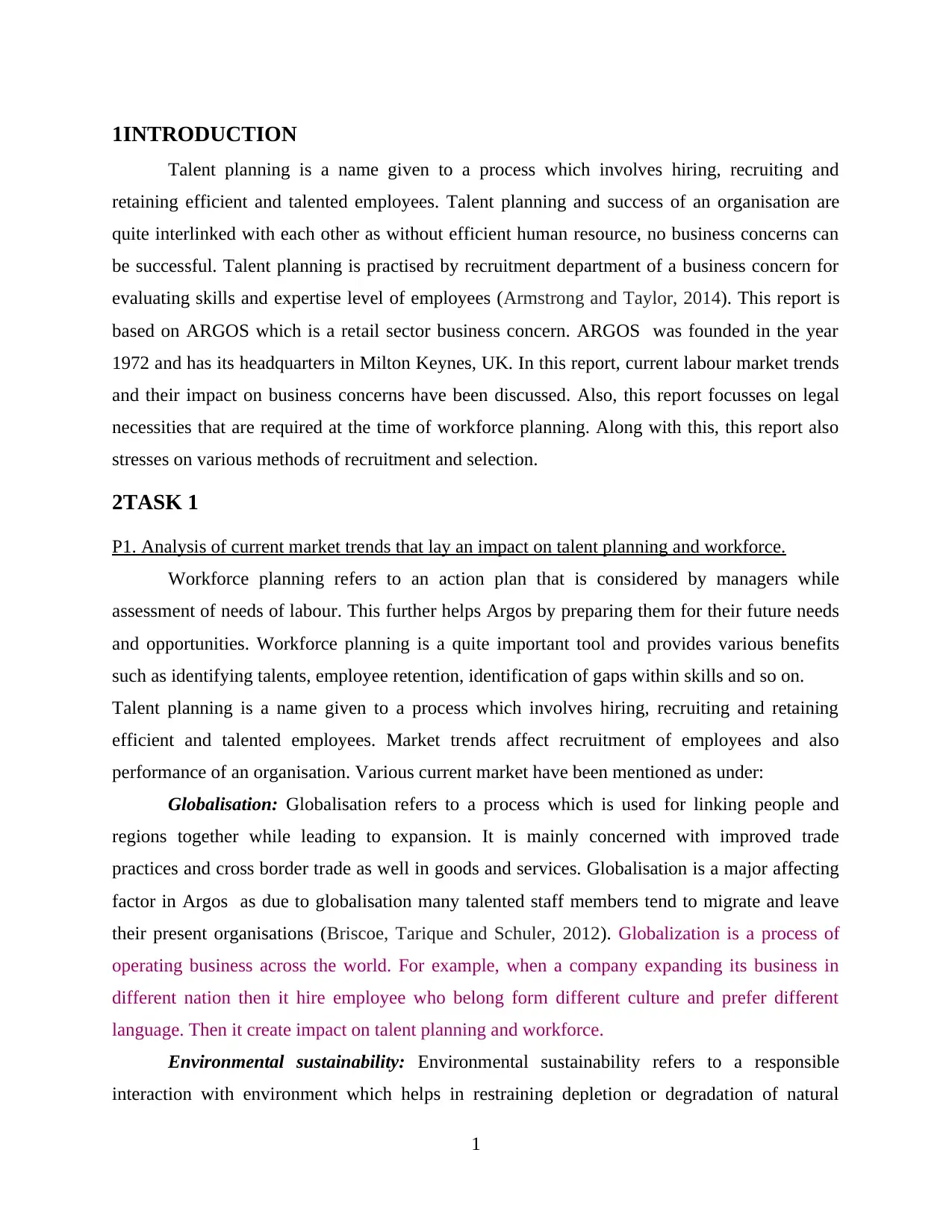
1INTRODUCTION
Talent planning is a name given to a process which involves hiring, recruiting and
retaining efficient and talented employees. Talent planning and success of an organisation are
quite interlinked with each other as without efficient human resource, no business concerns can
be successful. Talent planning is practised by recruitment department of a business concern for
evaluating skills and expertise level of employees (Armstrong and Taylor, 2014). This report is
based on ARGOS which is a retail sector business concern. ARGOS was founded in the year
1972 and has its headquarters in Milton Keynes, UK. In this report, current labour market trends
and their impact on business concerns have been discussed. Also, this report focusses on legal
necessities that are required at the time of workforce planning. Along with this, this report also
stresses on various methods of recruitment and selection.
2TASK 1
P1. Analysis of current market trends that lay an impact on talent planning and workforce.
Workforce planning refers to an action plan that is considered by managers while
assessment of needs of labour. This further helps Argos by preparing them for their future needs
and opportunities. Workforce planning is a quite important tool and provides various benefits
such as identifying talents, employee retention, identification of gaps within skills and so on.
Talent planning is a name given to a process which involves hiring, recruiting and retaining
efficient and talented employees. Market trends affect recruitment of employees and also
performance of an organisation. Various current market have been mentioned as under:
Globalisation: Globalisation refers to a process which is used for linking people and
regions together while leading to expansion. It is mainly concerned with improved trade
practices and cross border trade as well in goods and services. Globalisation is a major affecting
factor in Argos as due to globalisation many talented staff members tend to migrate and leave
their present organisations (Briscoe, Tarique and Schuler, 2012). Globalization is a process of
operating business across the world. For example, when a company expanding its business in
different nation then it hire employee who belong form different culture and prefer different
language. Then it create impact on talent planning and workforce.
Environmental sustainability: Environmental sustainability refers to a responsible
interaction with environment which helps in restraining depletion or degradation of natural
1
Talent planning is a name given to a process which involves hiring, recruiting and
retaining efficient and talented employees. Talent planning and success of an organisation are
quite interlinked with each other as without efficient human resource, no business concerns can
be successful. Talent planning is practised by recruitment department of a business concern for
evaluating skills and expertise level of employees (Armstrong and Taylor, 2014). This report is
based on ARGOS which is a retail sector business concern. ARGOS was founded in the year
1972 and has its headquarters in Milton Keynes, UK. In this report, current labour market trends
and their impact on business concerns have been discussed. Also, this report focusses on legal
necessities that are required at the time of workforce planning. Along with this, this report also
stresses on various methods of recruitment and selection.
2TASK 1
P1. Analysis of current market trends that lay an impact on talent planning and workforce.
Workforce planning refers to an action plan that is considered by managers while
assessment of needs of labour. This further helps Argos by preparing them for their future needs
and opportunities. Workforce planning is a quite important tool and provides various benefits
such as identifying talents, employee retention, identification of gaps within skills and so on.
Talent planning is a name given to a process which involves hiring, recruiting and retaining
efficient and talented employees. Market trends affect recruitment of employees and also
performance of an organisation. Various current market have been mentioned as under:
Globalisation: Globalisation refers to a process which is used for linking people and
regions together while leading to expansion. It is mainly concerned with improved trade
practices and cross border trade as well in goods and services. Globalisation is a major affecting
factor in Argos as due to globalisation many talented staff members tend to migrate and leave
their present organisations (Briscoe, Tarique and Schuler, 2012). Globalization is a process of
operating business across the world. For example, when a company expanding its business in
different nation then it hire employee who belong form different culture and prefer different
language. Then it create impact on talent planning and workforce.
Environmental sustainability: Environmental sustainability refers to a responsible
interaction with environment which helps in restraining depletion or degradation of natural
1
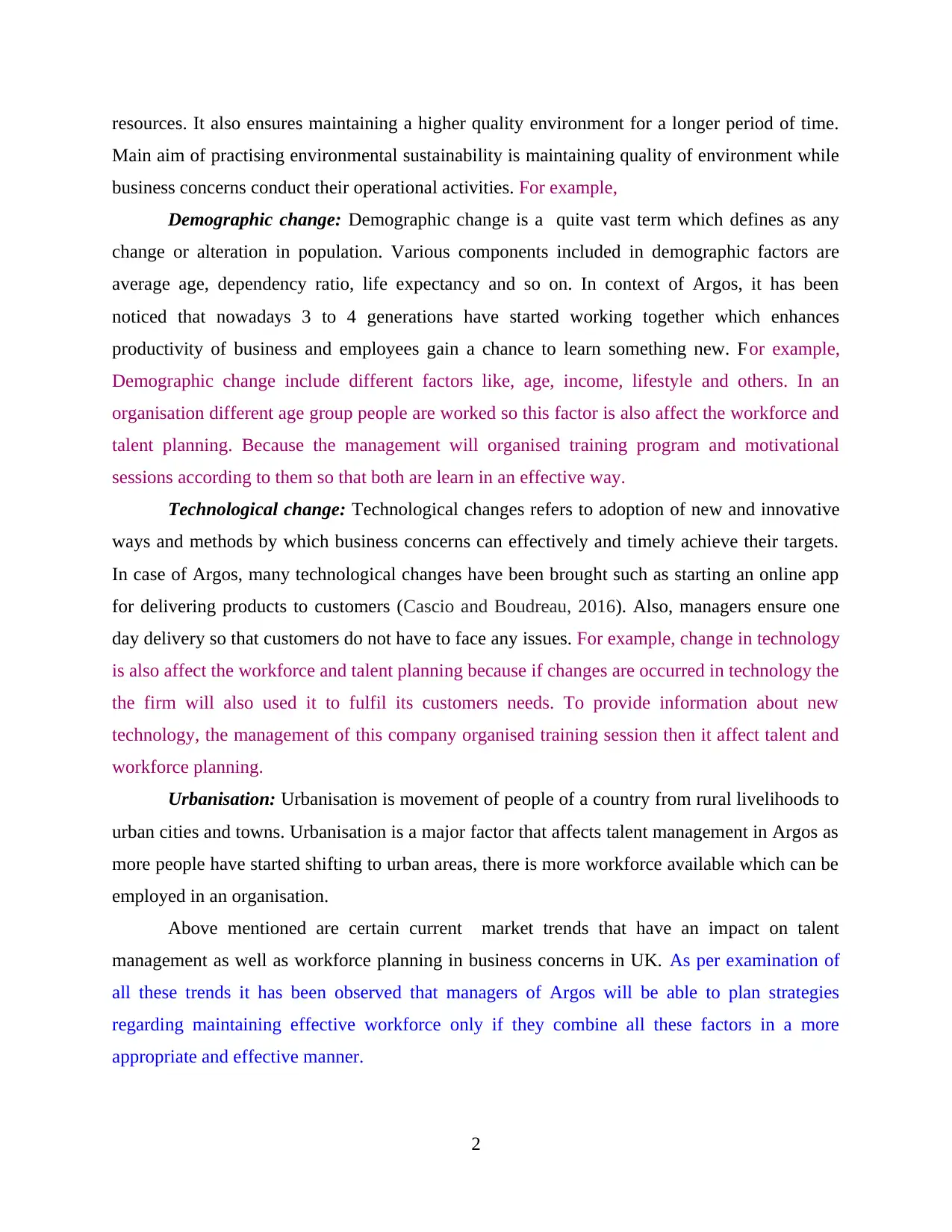
resources. It also ensures maintaining a higher quality environment for a longer period of time.
Main aim of practising environmental sustainability is maintaining quality of environment while
business concerns conduct their operational activities. For example,
Demographic change: Demographic change is a quite vast term which defines as any
change or alteration in population. Various components included in demographic factors are
average age, dependency ratio, life expectancy and so on. In context of Argos, it has been
noticed that nowadays 3 to 4 generations have started working together which enhances
productivity of business and employees gain a chance to learn something new. For example,
Demographic change include different factors like, age, income, lifestyle and others. In an
organisation different age group people are worked so this factor is also affect the workforce and
talent planning. Because the management will organised training program and motivational
sessions according to them so that both are learn in an effective way.
Technological change: Technological changes refers to adoption of new and innovative
ways and methods by which business concerns can effectively and timely achieve their targets.
In case of Argos, many technological changes have been brought such as starting an online app
for delivering products to customers (Cascio and Boudreau, 2016). Also, managers ensure one
day delivery so that customers do not have to face any issues. For example, change in technology
is also affect the workforce and talent planning because if changes are occurred in technology the
the firm will also used it to fulfil its customers needs. To provide information about new
technology, the management of this company organised training session then it affect talent and
workforce planning.
Urbanisation: Urbanisation is movement of people of a country from rural livelihoods to
urban cities and towns. Urbanisation is a major factor that affects talent management in Argos as
more people have started shifting to urban areas, there is more workforce available which can be
employed in an organisation.
Above mentioned are certain current market trends that have an impact on talent
management as well as workforce planning in business concerns in UK. As per examination of
all these trends it has been observed that managers of Argos will be able to plan strategies
regarding maintaining effective workforce only if they combine all these factors in a more
appropriate and effective manner.
2
Main aim of practising environmental sustainability is maintaining quality of environment while
business concerns conduct their operational activities. For example,
Demographic change: Demographic change is a quite vast term which defines as any
change or alteration in population. Various components included in demographic factors are
average age, dependency ratio, life expectancy and so on. In context of Argos, it has been
noticed that nowadays 3 to 4 generations have started working together which enhances
productivity of business and employees gain a chance to learn something new. For example,
Demographic change include different factors like, age, income, lifestyle and others. In an
organisation different age group people are worked so this factor is also affect the workforce and
talent planning. Because the management will organised training program and motivational
sessions according to them so that both are learn in an effective way.
Technological change: Technological changes refers to adoption of new and innovative
ways and methods by which business concerns can effectively and timely achieve their targets.
In case of Argos, many technological changes have been brought such as starting an online app
for delivering products to customers (Cascio and Boudreau, 2016). Also, managers ensure one
day delivery so that customers do not have to face any issues. For example, change in technology
is also affect the workforce and talent planning because if changes are occurred in technology the
the firm will also used it to fulfil its customers needs. To provide information about new
technology, the management of this company organised training session then it affect talent and
workforce planning.
Urbanisation: Urbanisation is movement of people of a country from rural livelihoods to
urban cities and towns. Urbanisation is a major factor that affects talent management in Argos as
more people have started shifting to urban areas, there is more workforce available which can be
employed in an organisation.
Above mentioned are certain current market trends that have an impact on talent
management as well as workforce planning in business concerns in UK. As per examination of
all these trends it has been observed that managers of Argos will be able to plan strategies
regarding maintaining effective workforce only if they combine all these factors in a more
appropriate and effective manner.
2
⊘ This is a preview!⊘
Do you want full access?
Subscribe today to unlock all pages.

Trusted by 1+ million students worldwide
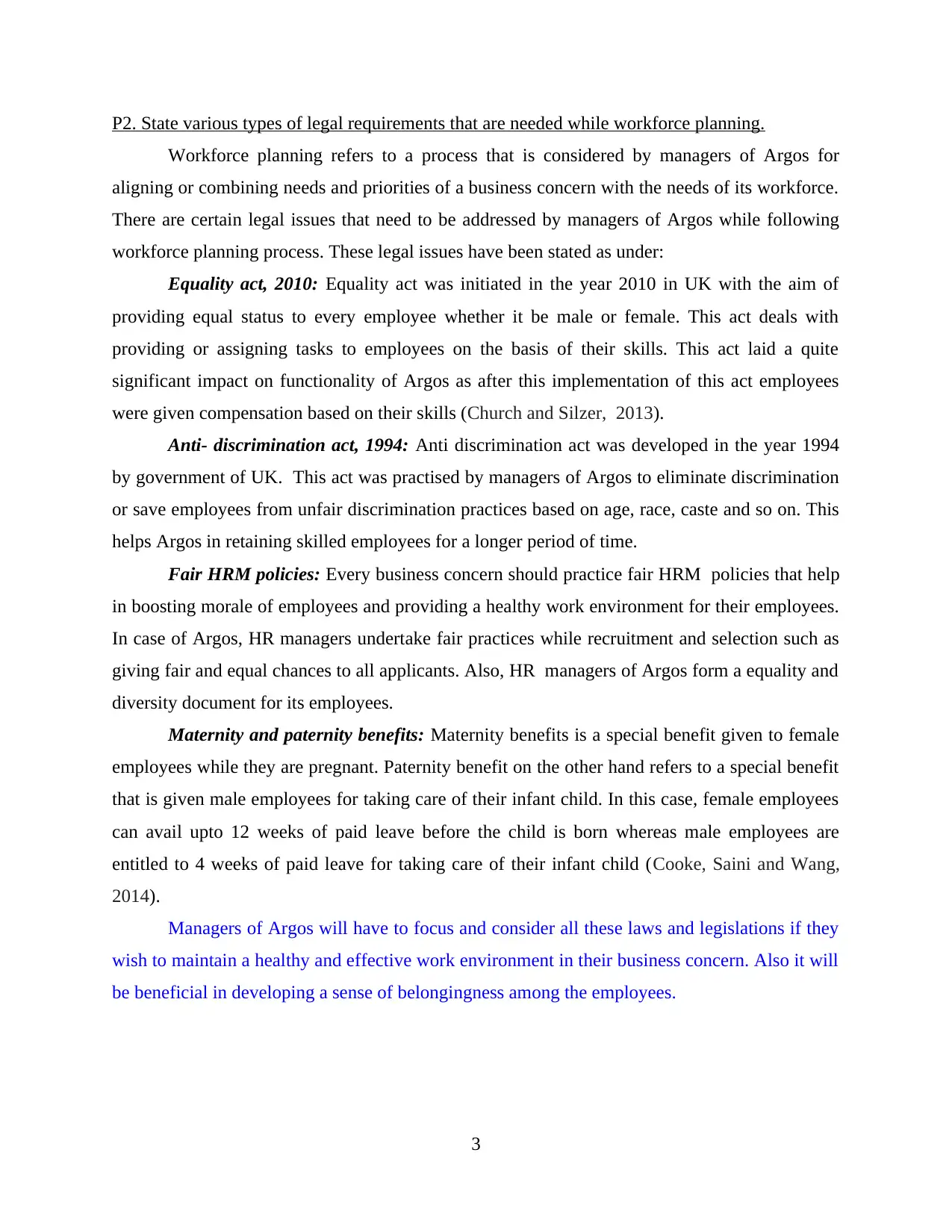
P2. State various types of legal requirements that are needed while workforce planning.
Workforce planning refers to a process that is considered by managers of Argos for
aligning or combining needs and priorities of a business concern with the needs of its workforce.
There are certain legal issues that need to be addressed by managers of Argos while following
workforce planning process. These legal issues have been stated as under:
Equality act, 2010: Equality act was initiated in the year 2010 in UK with the aim of
providing equal status to every employee whether it be male or female. This act deals with
providing or assigning tasks to employees on the basis of their skills. This act laid a quite
significant impact on functionality of Argos as after this implementation of this act employees
were given compensation based on their skills (Church and Silzer, 2013).
Anti- discrimination act, 1994: Anti discrimination act was developed in the year 1994
by government of UK. This act was practised by managers of Argos to eliminate discrimination
or save employees from unfair discrimination practices based on age, race, caste and so on. This
helps Argos in retaining skilled employees for a longer period of time.
Fair HRM policies: Every business concern should practice fair HRM policies that help
in boosting morale of employees and providing a healthy work environment for their employees.
In case of Argos, HR managers undertake fair practices while recruitment and selection such as
giving fair and equal chances to all applicants. Also, HR managers of Argos form a equality and
diversity document for its employees.
Maternity and paternity benefits: Maternity benefits is a special benefit given to female
employees while they are pregnant. Paternity benefit on the other hand refers to a special benefit
that is given male employees for taking care of their infant child. In this case, female employees
can avail upto 12 weeks of paid leave before the child is born whereas male employees are
entitled to 4 weeks of paid leave for taking care of their infant child (Cooke, Saini and Wang,
2014).
Managers of Argos will have to focus and consider all these laws and legislations if they
wish to maintain a healthy and effective work environment in their business concern. Also it will
be beneficial in developing a sense of belongingness among the employees.
3
Workforce planning refers to a process that is considered by managers of Argos for
aligning or combining needs and priorities of a business concern with the needs of its workforce.
There are certain legal issues that need to be addressed by managers of Argos while following
workforce planning process. These legal issues have been stated as under:
Equality act, 2010: Equality act was initiated in the year 2010 in UK with the aim of
providing equal status to every employee whether it be male or female. This act deals with
providing or assigning tasks to employees on the basis of their skills. This act laid a quite
significant impact on functionality of Argos as after this implementation of this act employees
were given compensation based on their skills (Church and Silzer, 2013).
Anti- discrimination act, 1994: Anti discrimination act was developed in the year 1994
by government of UK. This act was practised by managers of Argos to eliminate discrimination
or save employees from unfair discrimination practices based on age, race, caste and so on. This
helps Argos in retaining skilled employees for a longer period of time.
Fair HRM policies: Every business concern should practice fair HRM policies that help
in boosting morale of employees and providing a healthy work environment for their employees.
In case of Argos, HR managers undertake fair practices while recruitment and selection such as
giving fair and equal chances to all applicants. Also, HR managers of Argos form a equality and
diversity document for its employees.
Maternity and paternity benefits: Maternity benefits is a special benefit given to female
employees while they are pregnant. Paternity benefit on the other hand refers to a special benefit
that is given male employees for taking care of their infant child. In this case, female employees
can avail upto 12 weeks of paid leave before the child is born whereas male employees are
entitled to 4 weeks of paid leave for taking care of their infant child (Cooke, Saini and Wang,
2014).
Managers of Argos will have to focus and consider all these laws and legislations if they
wish to maintain a healthy and effective work environment in their business concern. Also it will
be beneficial in developing a sense of belongingness among the employees.
3
Paraphrase This Document
Need a fresh take? Get an instant paraphrase of this document with our AI Paraphraser
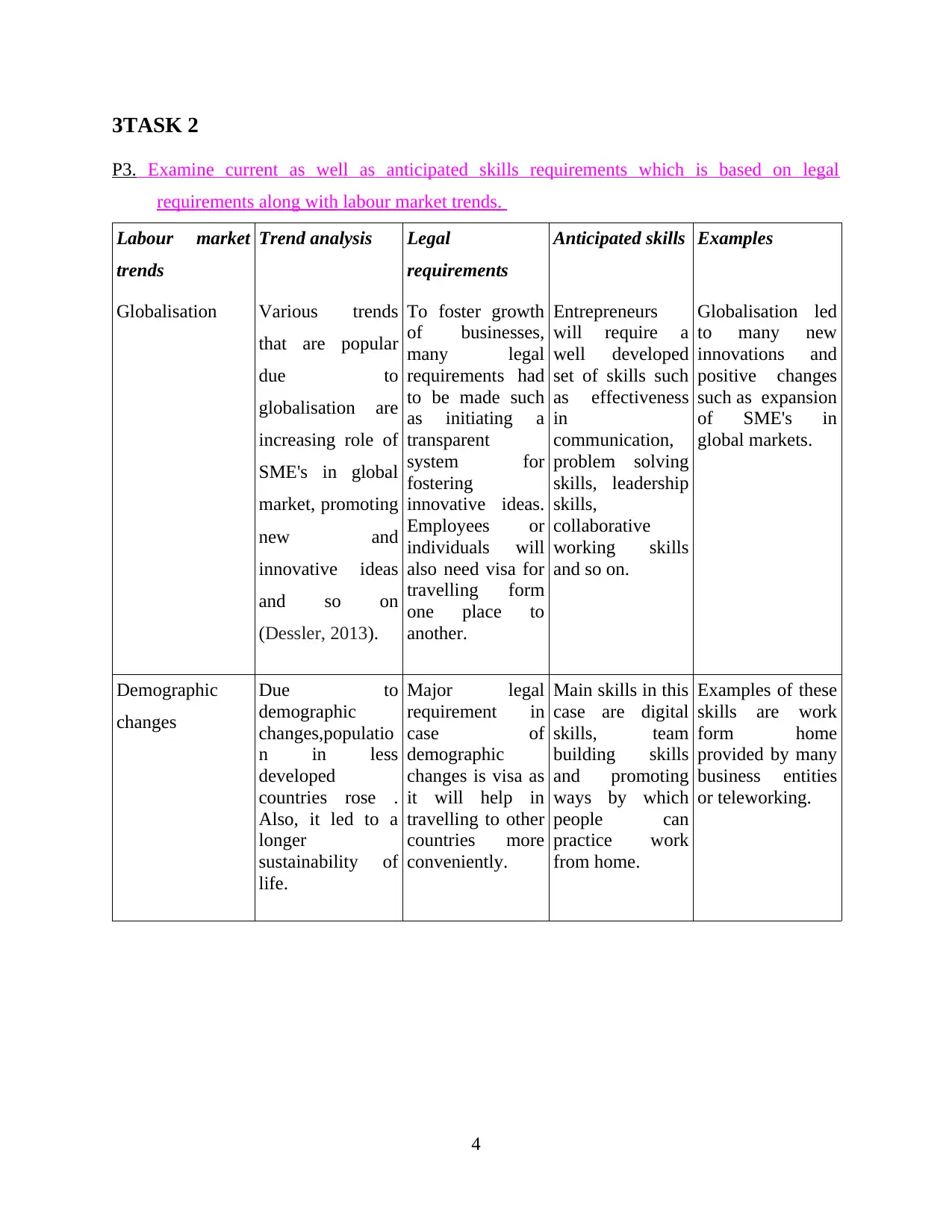
3TASK 2
P3. Examine current as well as anticipated skills requirements which is based on legal
requirements along with labour market trends.
Labour market
trends
Trend analysis Legal
requirements
Anticipated skills Examples
Globalisation Various trends
that are popular
due to
globalisation are
increasing role of
SME's in global
market, promoting
new and
innovative ideas
and so on
(Dessler, 2013).
To foster growth
of businesses,
many legal
requirements had
to be made such
as initiating a
transparent
system for
fostering
innovative ideas.
Employees or
individuals will
also need visa for
travelling form
one place to
another.
Entrepreneurs
will require a
well developed
set of skills such
as effectiveness
in
communication,
problem solving
skills, leadership
skills,
collaborative
working skills
and so on.
Globalisation led
to many new
innovations and
positive changes
such as expansion
of SME's in
global markets.
Demographic
changes
Due to
demographic
changes,populatio
n in less
developed
countries rose .
Also, it led to a
longer
sustainability of
life.
Major legal
requirement in
case of
demographic
changes is visa as
it will help in
travelling to other
countries more
conveniently.
Main skills in this
case are digital
skills, team
building skills
and promoting
ways by which
people can
practice work
from home.
Examples of these
skills are work
form home
provided by many
business entities
or teleworking.
4
P3. Examine current as well as anticipated skills requirements which is based on legal
requirements along with labour market trends.
Labour market
trends
Trend analysis Legal
requirements
Anticipated skills Examples
Globalisation Various trends
that are popular
due to
globalisation are
increasing role of
SME's in global
market, promoting
new and
innovative ideas
and so on
(Dessler, 2013).
To foster growth
of businesses,
many legal
requirements had
to be made such
as initiating a
transparent
system for
fostering
innovative ideas.
Employees or
individuals will
also need visa for
travelling form
one place to
another.
Entrepreneurs
will require a
well developed
set of skills such
as effectiveness
in
communication,
problem solving
skills, leadership
skills,
collaborative
working skills
and so on.
Globalisation led
to many new
innovations and
positive changes
such as expansion
of SME's in
global markets.
Demographic
changes
Due to
demographic
changes,populatio
n in less
developed
countries rose .
Also, it led to a
longer
sustainability of
life.
Major legal
requirement in
case of
demographic
changes is visa as
it will help in
travelling to other
countries more
conveniently.
Main skills in this
case are digital
skills, team
building skills
and promoting
ways by which
people can
practice work
from home.
Examples of these
skills are work
form home
provided by many
business entities
or teleworking.
4
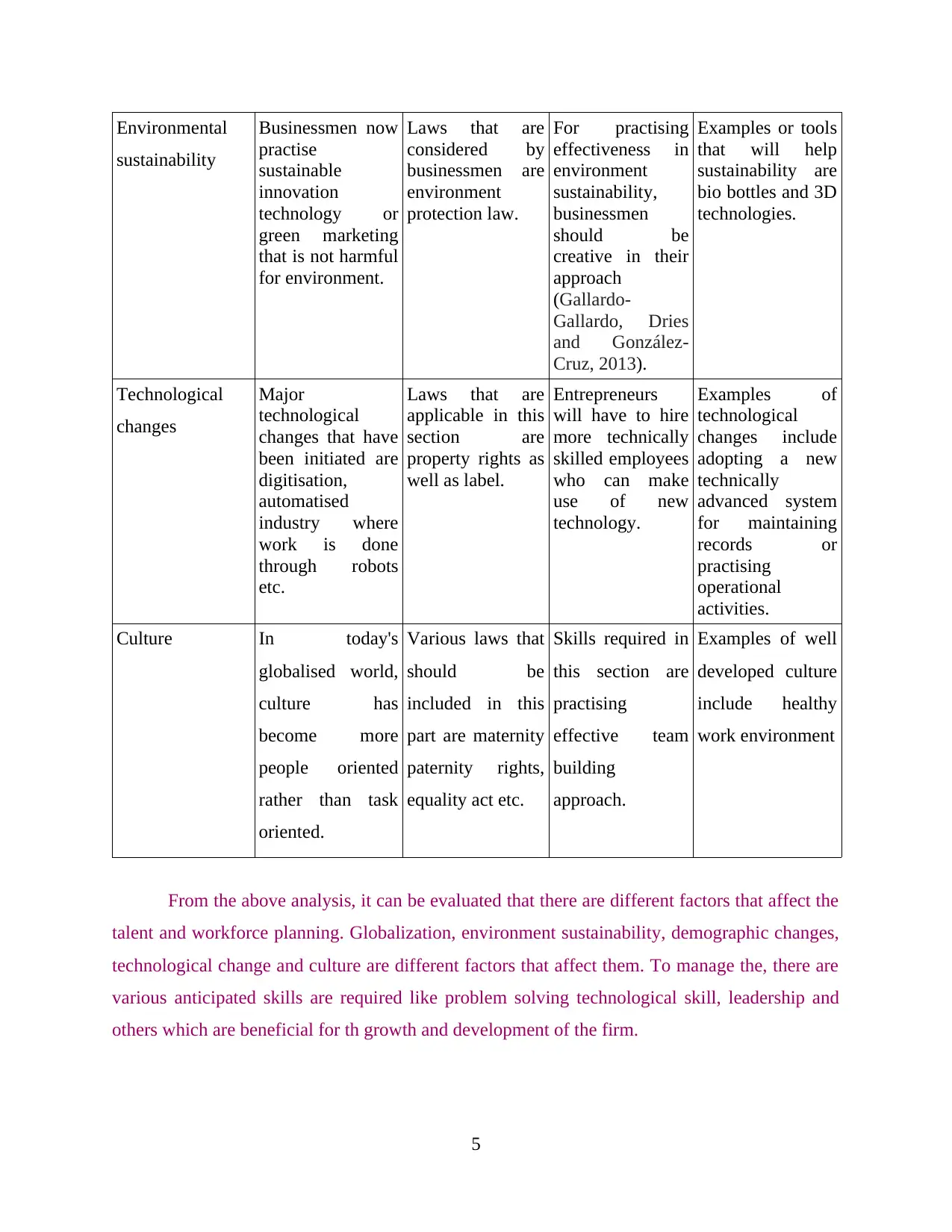
Environmental
sustainability
Businessmen now
practise
sustainable
innovation
technology or
green marketing
that is not harmful
for environment.
Laws that are
considered by
businessmen are
environment
protection law.
For practising
effectiveness in
environment
sustainability,
businessmen
should be
creative in their
approach
(Gallardo-
Gallardo, Dries
and González-
Cruz, 2013).
Examples or tools
that will help
sustainability are
bio bottles and 3D
technologies.
Technological
changes
Major
technological
changes that have
been initiated are
digitisation,
automatised
industry where
work is done
through robots
etc.
Laws that are
applicable in this
section are
property rights as
well as label.
Entrepreneurs
will have to hire
more technically
skilled employees
who can make
use of new
technology.
Examples of
technological
changes include
adopting a new
technically
advanced system
for maintaining
records or
practising
operational
activities.
Culture In today's
globalised world,
culture has
become more
people oriented
rather than task
oriented.
Various laws that
should be
included in this
part are maternity
paternity rights,
equality act etc.
Skills required in
this section are
practising
effective team
building
approach.
Examples of well
developed culture
include healthy
work environment
From the above analysis, it can be evaluated that there are different factors that affect the
talent and workforce planning. Globalization, environment sustainability, demographic changes,
technological change and culture are different factors that affect them. To manage the, there are
various anticipated skills are required like problem solving technological skill, leadership and
others which are beneficial for th growth and development of the firm.
5
sustainability
Businessmen now
practise
sustainable
innovation
technology or
green marketing
that is not harmful
for environment.
Laws that are
considered by
businessmen are
environment
protection law.
For practising
effectiveness in
environment
sustainability,
businessmen
should be
creative in their
approach
(Gallardo-
Gallardo, Dries
and González-
Cruz, 2013).
Examples or tools
that will help
sustainability are
bio bottles and 3D
technologies.
Technological
changes
Major
technological
changes that have
been initiated are
digitisation,
automatised
industry where
work is done
through robots
etc.
Laws that are
applicable in this
section are
property rights as
well as label.
Entrepreneurs
will have to hire
more technically
skilled employees
who can make
use of new
technology.
Examples of
technological
changes include
adopting a new
technically
advanced system
for maintaining
records or
practising
operational
activities.
Culture In today's
globalised world,
culture has
become more
people oriented
rather than task
oriented.
Various laws that
should be
included in this
part are maternity
paternity rights,
equality act etc.
Skills required in
this section are
practising
effective team
building
approach.
Examples of well
developed culture
include healthy
work environment
From the above analysis, it can be evaluated that there are different factors that affect the
talent and workforce planning. Globalization, environment sustainability, demographic changes,
technological change and culture are different factors that affect them. To manage the, there are
various anticipated skills are required like problem solving technological skill, leadership and
others which are beneficial for th growth and development of the firm.
5
⊘ This is a preview!⊘
Do you want full access?
Subscribe today to unlock all pages.

Trusted by 1+ million students worldwide
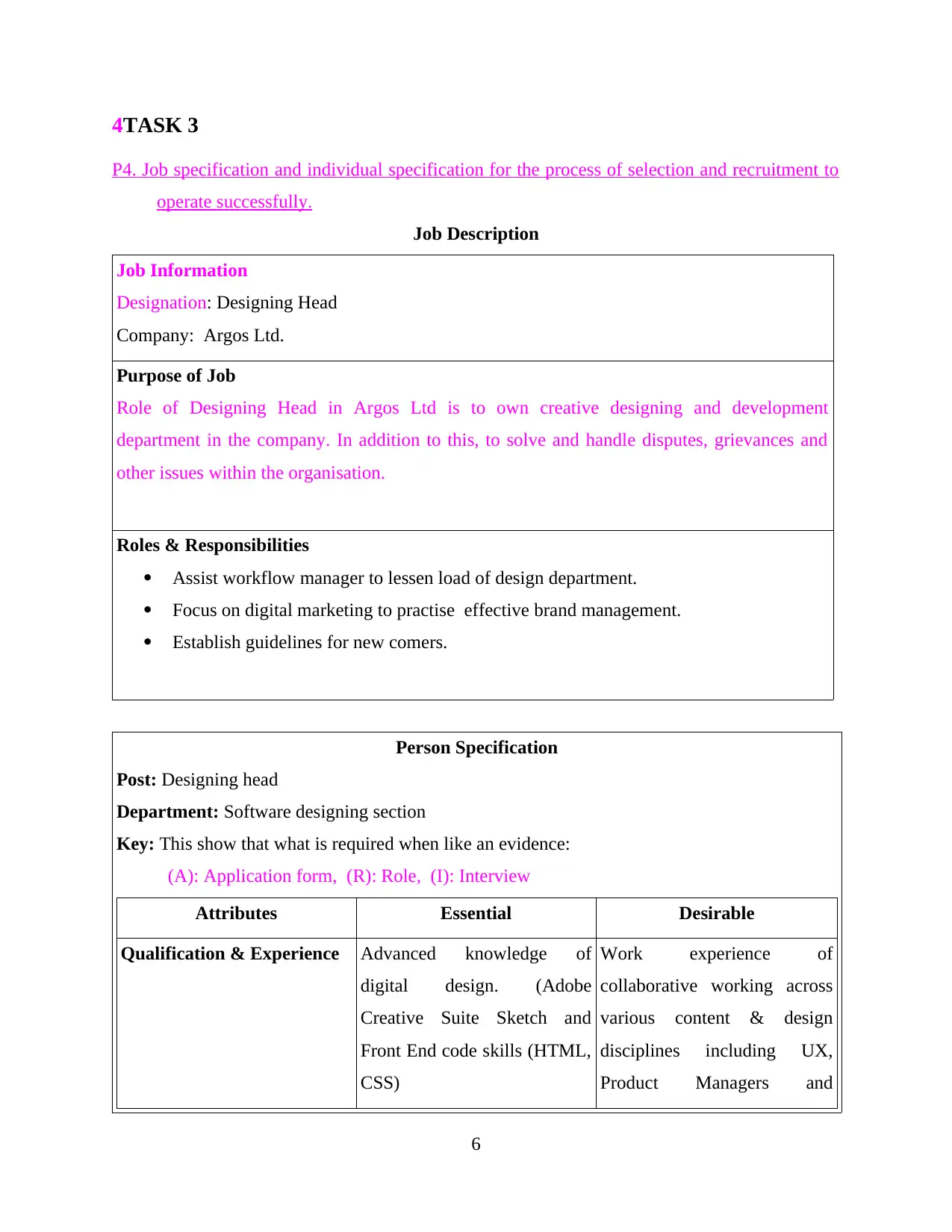
4TASK 3
P4. Job specification and individual specification for the process of selection and recruitment to
operate successfully.
Job Description
Job Information
Designation: Designing Head
Company: Argos Ltd.
Purpose of Job
Role of Designing Head in Argos Ltd is to own creative designing and development
department in the company. In addition to this, to solve and handle disputes, grievances and
other issues within the organisation.
Roles & Responsibilities
Assist workflow manager to lessen load of design department.
Focus on digital marketing to practise effective brand management.
Establish guidelines for new comers.
Person Specification
Post: Designing head
Department: Software designing section
Key: This show that what is required when like an evidence:
(A): Application form, (R): Role, (I): Interview
Attributes Essential Desirable
Qualification & Experience Advanced knowledge of
digital design. (Adobe
Creative Suite Sketch and
Front End code skills (HTML,
CSS)
Work experience of
collaborative working across
various content & design
disciplines including UX,
Product Managers and
6
P4. Job specification and individual specification for the process of selection and recruitment to
operate successfully.
Job Description
Job Information
Designation: Designing Head
Company: Argos Ltd.
Purpose of Job
Role of Designing Head in Argos Ltd is to own creative designing and development
department in the company. In addition to this, to solve and handle disputes, grievances and
other issues within the organisation.
Roles & Responsibilities
Assist workflow manager to lessen load of design department.
Focus on digital marketing to practise effective brand management.
Establish guidelines for new comers.
Person Specification
Post: Designing head
Department: Software designing section
Key: This show that what is required when like an evidence:
(A): Application form, (R): Role, (I): Interview
Attributes Essential Desirable
Qualification & Experience Advanced knowledge of
digital design. (Adobe
Creative Suite Sketch and
Front End code skills (HTML,
CSS)
Work experience of
collaborative working across
various content & design
disciplines including UX,
Product Managers and
6
Paraphrase This Document
Need a fresh take? Get an instant paraphrase of this document with our AI Paraphraser
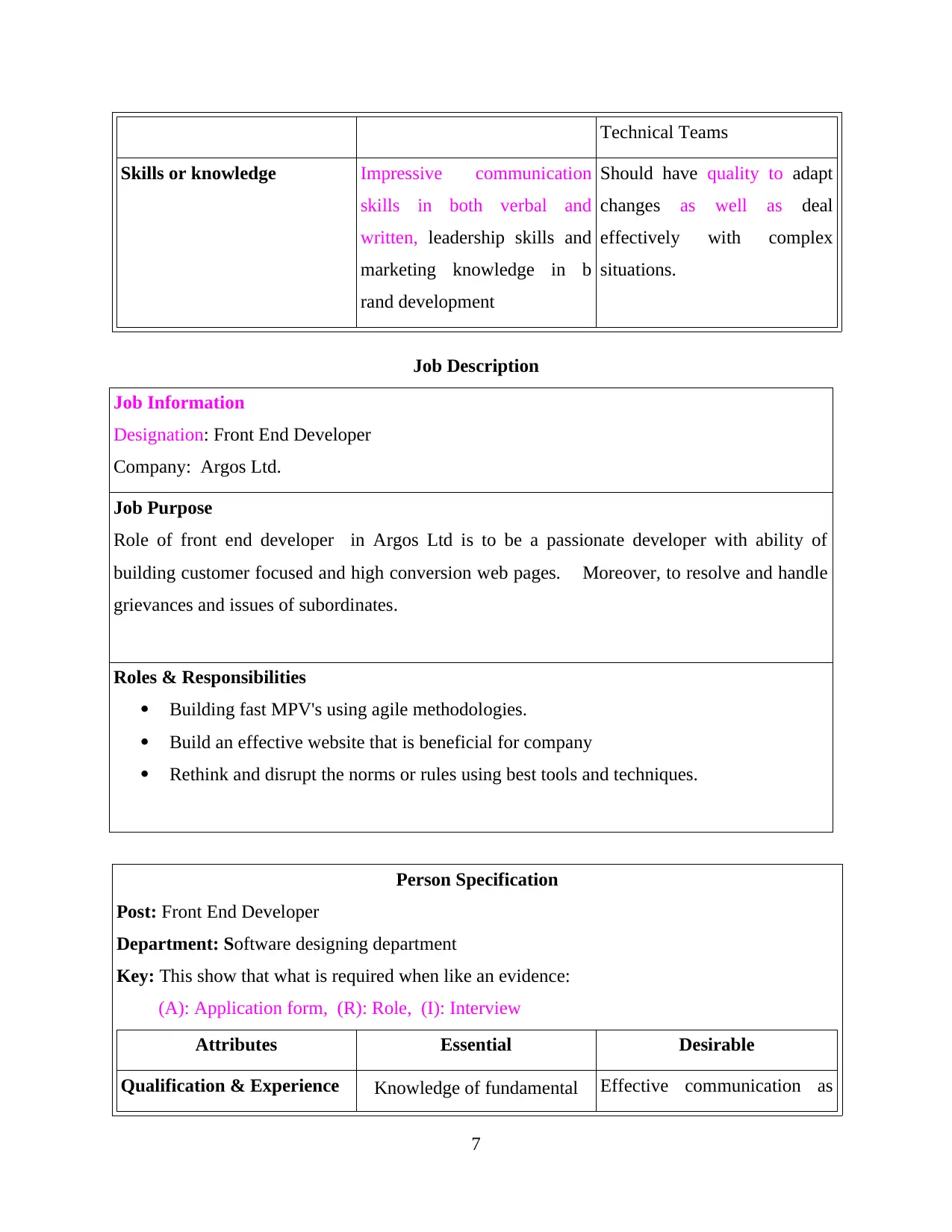
Technical Teams
Skills or knowledge Impressive communication
skills in both verbal and
written, leadership skills and
marketing knowledge in b
rand development
Should have quality to adapt
changes as well as deal
effectively with complex
situations.
Job Description
Job Information
Designation: Front End Developer
Company: Argos Ltd.
Job Purpose
Role of front end developer in Argos Ltd is to be a passionate developer with ability of
building customer focused and high conversion web pages. Moreover, to resolve and handle
grievances and issues of subordinates.
Roles & Responsibilities
Building fast MPV's using agile methodologies.
Build an effective website that is beneficial for company
Rethink and disrupt the norms or rules using best tools and techniques.
Person Specification
Post: Front End Developer
Department: Software designing department
Key: This show that what is required when like an evidence:
(A): Application form, (R): Role, (I): Interview
Attributes Essential Desirable
Qualification & Experience Knowledge of fundamental Effective communication as
7
Skills or knowledge Impressive communication
skills in both verbal and
written, leadership skills and
marketing knowledge in b
rand development
Should have quality to adapt
changes as well as deal
effectively with complex
situations.
Job Description
Job Information
Designation: Front End Developer
Company: Argos Ltd.
Job Purpose
Role of front end developer in Argos Ltd is to be a passionate developer with ability of
building customer focused and high conversion web pages. Moreover, to resolve and handle
grievances and issues of subordinates.
Roles & Responsibilities
Building fast MPV's using agile methodologies.
Build an effective website that is beneficial for company
Rethink and disrupt the norms or rules using best tools and techniques.
Person Specification
Post: Front End Developer
Department: Software designing department
Key: This show that what is required when like an evidence:
(A): Application form, (R): Role, (I): Interview
Attributes Essential Desirable
Qualification & Experience Knowledge of fundamental Effective communication as
7
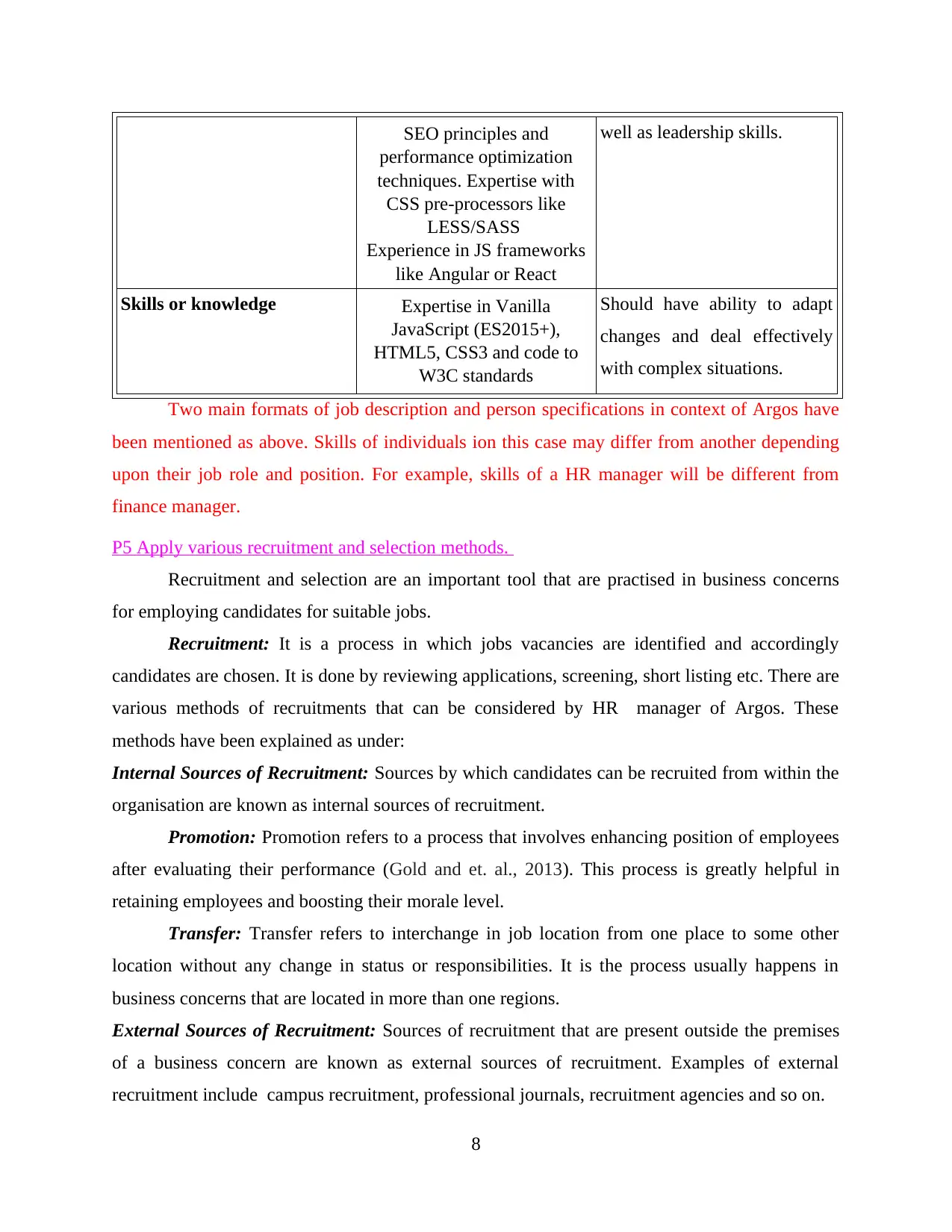
SEO principles and
performance optimization
techniques. Expertise with
CSS pre-processors like
LESS/SASS
Experience in JS frameworks
like Angular or React
well as leadership skills.
Skills or knowledge Expertise in Vanilla
JavaScript (ES2015+),
HTML5, CSS3 and code to
W3C standards
Should have ability to adapt
changes and deal effectively
with complex situations.
Two main formats of job description and person specifications in context of Argos have
been mentioned as above. Skills of individuals ion this case may differ from another depending
upon their job role and position. For example, skills of a HR manager will be different from
finance manager.
P5 Apply various recruitment and selection methods.
Recruitment and selection are an important tool that are practised in business concerns
for employing candidates for suitable jobs.
Recruitment: It is a process in which jobs vacancies are identified and accordingly
candidates are chosen. It is done by reviewing applications, screening, short listing etc. There are
various methods of recruitments that can be considered by HR manager of Argos. These
methods have been explained as under:
Internal Sources of Recruitment: Sources by which candidates can be recruited from within the
organisation are known as internal sources of recruitment.
Promotion: Promotion refers to a process that involves enhancing position of employees
after evaluating their performance (Gold and et. al., 2013). This process is greatly helpful in
retaining employees and boosting their morale level.
Transfer: Transfer refers to interchange in job location from one place to some other
location without any change in status or responsibilities. It is the process usually happens in
business concerns that are located in more than one regions.
External Sources of Recruitment: Sources of recruitment that are present outside the premises
of a business concern are known as external sources of recruitment. Examples of external
recruitment include campus recruitment, professional journals, recruitment agencies and so on.
8
performance optimization
techniques. Expertise with
CSS pre-processors like
LESS/SASS
Experience in JS frameworks
like Angular or React
well as leadership skills.
Skills or knowledge Expertise in Vanilla
JavaScript (ES2015+),
HTML5, CSS3 and code to
W3C standards
Should have ability to adapt
changes and deal effectively
with complex situations.
Two main formats of job description and person specifications in context of Argos have
been mentioned as above. Skills of individuals ion this case may differ from another depending
upon their job role and position. For example, skills of a HR manager will be different from
finance manager.
P5 Apply various recruitment and selection methods.
Recruitment and selection are an important tool that are practised in business concerns
for employing candidates for suitable jobs.
Recruitment: It is a process in which jobs vacancies are identified and accordingly
candidates are chosen. It is done by reviewing applications, screening, short listing etc. There are
various methods of recruitments that can be considered by HR manager of Argos. These
methods have been explained as under:
Internal Sources of Recruitment: Sources by which candidates can be recruited from within the
organisation are known as internal sources of recruitment.
Promotion: Promotion refers to a process that involves enhancing position of employees
after evaluating their performance (Gold and et. al., 2013). This process is greatly helpful in
retaining employees and boosting their morale level.
Transfer: Transfer refers to interchange in job location from one place to some other
location without any change in status or responsibilities. It is the process usually happens in
business concerns that are located in more than one regions.
External Sources of Recruitment: Sources of recruitment that are present outside the premises
of a business concern are known as external sources of recruitment. Examples of external
recruitment include campus recruitment, professional journals, recruitment agencies and so on.
8
⊘ This is a preview!⊘
Do you want full access?
Subscribe today to unlock all pages.

Trusted by 1+ million students worldwide
1 out of 18
Related Documents
Your All-in-One AI-Powered Toolkit for Academic Success.
+13062052269
info@desklib.com
Available 24*7 on WhatsApp / Email
![[object Object]](/_next/static/media/star-bottom.7253800d.svg)
Unlock your academic potential
Copyright © 2020–2025 A2Z Services. All Rights Reserved. Developed and managed by ZUCOL.





